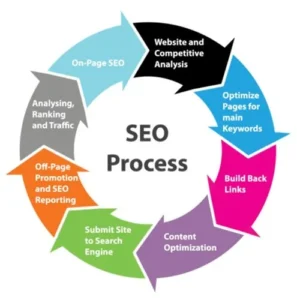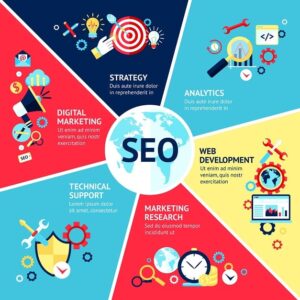What is search Engine Optimization
SEO (Search Engine Optimization) is the process of optimizing a website to improve its visibility and rankings on search engine results pages (SERPs). It involves various strategies, including keyword research, on-page optimization (like meta tags, headers, and content), technical SEO (such as site speed and mobile-friendliness), and link building. The goal is to increase organic (non-paid) traffic by aligning a website with search engine algorithms and user intent. SEO helps businesses gain more visibility, attract relevant visitors, improve user experience, and ultimately, drive conversions. Effective SEO leads to long-term growth, cost savings, and improved online presence in competitive markets.
Why is Search Engine Optimization needed?
SEO is essential because it helps businesses improve their visibility in search engine results, driving targeted, organic traffic to their websites. By optimizing content, structure, and technical elements, SEO enhances user experience, boosts brand credibility, and increases conversions. It offers long-term growth and a cost-effective way to generate leads compared to paid ads. With higher rankings, businesses can outperform competitors, gain local visibility, and build trust with users, ultimately leading to greater success in the digital marketplace.
Here are some additional points on why SEO is needed:
1. Increased Organic Traffic:- SEO drives free, organic traffic from search engines, which is more sustainable and cost-effective compared to paid advertising.
2. Improved User Experience:- SEO focuses on website usability, such as fast loading times and mobile optimization, which enhances the overall user experience and keeps visitors engaged.
3. Higher Conversion Rates:- SEO brings in targeted traffic, meaning visitors are more likely to convert into customers since they are already searching for relevant products or services.
4. Building Brand Credibility:- High search rankings help build trust and credibility with users. People tend to trust websites that appear at the top of search results.
5. Competitive Advantage:- Businesses that invest in SEO are more likely to outrank competitors in search results, gaining a competitive edge in their industry.
6. Long-term Growth:- While SEO takes time to show results, its effects are long-lasting, making it an important strategy for sustained business growth and online visibility.
7. Cost-Effective Marketing:- Compared to paid ads, SEO offers a more cost-effective way to increase visibility without the ongoing expenses of PPC campaigns.
8. Local Search Visibility:- Local SEO helps businesses appear in location-based searches, making it crucial for businesses aiming to attract customers in specific geographic areas.
9. Better ROI:- SEO provides measurable results, allowing businesses to track performance and continuously refine strategies for better return on investment (ROI).
10. Staying Relevant:- As search engines evolve, SEO ensures your business stays up to date with the latest trends, algorithms, and best practices, maintaining your competitiveness in the market.
9 steps to establish a SEO:-
- Website Audit
- Keyword Research
- On-Page Optimization
- Content Creation & Optimization
- Technical SEO
- Link Building
- Local SEO (if applicable)
- Performance Monitoring
- Ongoing Optimization
Other SEO Services we provide
Conversion Rate Optimization (CRO)
Conversion Rate Optimization (CRO) is the practice of enhancing a website, landing page, or digital marketing strategy to increase the percentage of visitors who take a desired action. These actions, known as conversions, can include making a purchase, signing up for a newsletter, filling out a contact form, or downloading a resource. CRO focuses on improving the efficiency of the conversion funnel to maximize the value of existing traffic rather than solely driving more visitors to a site.
The CRO process begins with analyzing data to understand user behavior and identifying potential bottlenecks or barriers to conversions. Tools like web analytics platforms, heatmaps, session recordings, and user surveys provide insights into how users interact with a site. Based on this analysis, hypotheses are developed to address the identified issues.
Common CRO strategies include simplifying navigation, optimizing the checkout process, improving page load times, creating compelling calls-to-action (CTAs), and testing different headlines, layouts, or designs. A/B testing, multivariate testing, and usability testing are core methodologies used to validate these changes.
CRO is iterative and relies on continuous testing and refinement. The ultimate goal is to create a seamless, user-friendly experience that aligns with customer needs and business objectives. By focusing on conversion optimization, businesses can improve their return on investment (ROI) without increasing marketing spend, as even small improvements in conversion rates can significantly impact revenue.
CRO is beneficial for businesses of all sizes and industries, helping them better understand their audience, reduce customer acquisition costs, and achieve sustainable growth. It ensures that the traffic generated through marketing efforts is used effectively, making CRO a vital component of modern digital marketing strategies.
Content Marketing & Optimization
Content Marketing & Optimization focuses on creating, refining, and promoting high-quality content to attract, engage, and convert a target audience while improving a website’s search engine rankings. It is a key component of digital marketing that aligns valuable content with user intent and search engine algorithms.
Content Marketing
Content marketing involves producing relevant and valuable material tailored to your audience’s needs and interests. This can include blog posts, articles, videos, infographics, case studies, eBooks, and more. The goal is to establish authority, build trust, and drive organic traffic by addressing audience pain points and offering solutions. By creating content that answers user queries and provides actionable insights, businesses can position themselves as industry leaders and nurture customer relationships.
Content Optimization
Content optimization ensures that content is structured and presented in a way that maximizes its visibility in search engine results. This involves integrating targeted keywords, optimizing meta tags, titles, headers, and descriptions, as well as improving readability and engagement. Other critical elements include ensuring mobile-friendliness, fast loading speeds, and the inclusion of internal and external links for better user experience and SEO value.
Local SEO
Local SEO (Search Engine Optimization) is the practice of optimizing a business’s online presence to attract more customers from local search queries, which often include geographic terms like “near me” or specific city names. It is particularly important for businesses that operate in specific locations or serve local customers, such as restaurants, retail stores, medical practices, or service providers. The primary goal of local SEO is to increase visibility in search results for users seeking products or services within a specific area.
A key component of local SEO is optimizing a Google My Business (GMB) profile. This involves providing accurate and detailed information, such as the business name, address, phone number, operating hours, and customer reviews, which helps businesses appear in Google’s “Local Pack” (the map and top three local listings on search results). Consistency in NAP (Name, Address, and Phone Number) details across directories, websites, and social media platforms is crucial, as discrepancies can harm local rankings. Incorporating location-specific keywords into website content, meta tags, and headings further helps search engines associate the business with the targeted geographic area.
Customer reviews play a significant role in local SEO by boosting credibility and influencing search rankings. Encouraging satisfied customers to leave positive reviews on platforms like Google, Yelp, or industry-specific sites can enhance a business’s online reputation. Additionally, creating localized content, such as blog posts or event updates, and optimizing for mobile devices ensures that the business meets the needs of users who frequently conduct local searches on their smartphones.
By implementing local SEO strategies, businesses can improve their visibility in search engine results, connect with nearby customers, drive more foot traffic, and ultimately increase sales, making it an essential aspect of digital marketing for location-dependent organizations.
Ecommerce SEO
Ecommerce SEO is the process of optimizing an online store to improve its visibility in search engine results pages (SERPs), driving more organic traffic and increasing sales. Unlike traditional websites, ecommerce sites require unique strategies to ensure that a wide range of product pages, categories, and collections rank well for relevant search queries. The primary focus of ecommerce SEO is to align the store’s content, structure, and technical aspects with search engine algorithms while delivering an exceptional user experience.
Key aspects of ecommerce SEO include keyword research, on-page optimization, and technical SEO. Keyword research is crucial for identifying terms customers use to search for products, such as long-tail keywords like “affordable wireless headphones” or “organic skincare products.” These keywords are then incorporated into product titles, descriptions, meta tags, and URLs to improve discoverability. Optimizing product pages with high-quality images, detailed descriptions, and unique content helps to avoid duplicate content issues and enhance user engagement.
Technical SEO plays a significant role in ecommerce sites, focusing on factors such as fast-loading pages, mobile responsiveness, secure connections (HTTPS), and proper site architecture. Creating a well-structured sitemap and using breadcrumbs make navigation intuitive for both users and search engines. Additionally, ecommerce SEO emphasizes the importance of building backlinks from reputable sources and encouraging customer reviews to enhance credibility.
Another essential element is optimizing for local searches if the ecommerce store has physical locations or offers regional delivery options. Regularly updating content, addressing user queries, and maintaining a blog for relevant industry insights can further boost rankings. By effectively implementing ecommerce SEO strategies, online stores can increase visibility, drive qualified traffic, improve user experience, and ultimately boost sales, making it a critical aspect of digital marketing in the competitive online marketplace.
Why your website does not rank in Google?
Your website might not rank in Google due to poor indexing, lack of keyword optimization, low-quality or duplicate content, technical SEO problems like slow loading speed, weak backlinks, penalties for guideline violations, or strong competition in your niche..
What are the issues responsible for not ranking?

Issues preventing ranking include poor website indexing, lack of proper keyword optimization, thin or duplicate content, slow page load times, mobile usability problems, weak backlinks, technical errors, Google penalties, and fierce competition in your industry or niche.
Major parameters and SEO Ranking Factors
Major SEO ranking factors include high-quality content, relevant keywords, mobile-friendliness, page load speed, user experience, backlinks, technical SEO (like site structure and HTTPS), secure and accessible website, on-page optimization (titles, meta tags), and domain authority.





